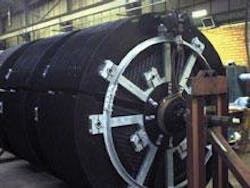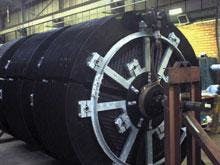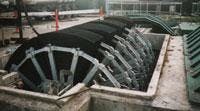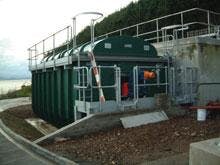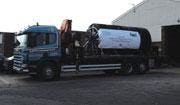Properly designed RBCs solve mechanical issues
By G. Eric Findley
A new rotating biological contactor (RBC) design by the Cranfield University School of Mechanical Engineering and Copa Ltd. for Severn Trent Water Ltd resolved mechanical reliability issues of RBCs in sewage treatment plants. Consequently, the Institution of Mechanical Engineers (UK) recognised Copa Ltd as a finalist for its Manufacturing Excellence Awards in July 2003.
Since 1989, the UK water company Severn Trent Water recognised the process and economic advantages of RBCs and adopted the technology as the main process in their small sewage treatment plants. Properly designed, the process produces a well-nitrified effluent, is environmentally friendly and inexpensive to operate. Installing several plants in parallel can treat populations up to 3,000. The advantage of such an arrangement is that the cost of the civil works is less than if a typical percolating filter flow sheet is adopted. Sludge is removed every 90 days and screenings and detritus are contained within the plant.
Mechanical engineering problems, however, became apparent in RBC operations, so Severn Trent Water commissioned Cranfield University to investigate the reasons for RBC failure and to recommend improvements to Severn Trent specifications.
Severn Trent Water Ltd sponsored a doctoral student to investigate more than 300 operational units in the Midlands region of England, which are owned and operated by Severn Trent Water. The researcher examined and reviewed every aspect of the mechanical plant, and senior staff specialising in rotating machinery undertook calculations based on Finite Element and traditional analyses and supervised the project whilst liasing closely with Severn Trent Water.
Severn Trent requested that Cranfield's design ensure the rotating metal assembly to remain defect-free for a minimum of 20 years at the specified conditions of 5 mm biomass thickness on the coarse disc packs and 3 mm on the fine packs. This means that maintenance is now restricted to lubricating bearings and the gearbox, and removing sludge produced by the process. This design change has altered the RBC process, which was considered unreliable, to being one of the most robust small mechanical sewage treatment plants. This, however, applies to those plants validated by Cranfield and Copa Ltd.
Cranfield identified several factors that led to design changes. Researchers found that RBCs fail primarily from fatigue rather than corrosion; however other factors play a significant role in mechanical failure, such as biomass thickness, environment; rotation speed and quality of manufacture and assembly.
Biomass thickness
An RBC frame is no more than a rotating portal structure. Consequently, the biomass load is the uniformly distributed load acting on "the beam." The bending moment and stresses are a function of the biomass thickness; therefore it is extremely important in any design to specify thickness. A plant experiencing a load of five mm is likely to fail quite rapidly if it has been designed to accept only two. Since the stress is proportional to the thickness to the power of three, this has quite a major effect.
A detailed measurement of biomass thickness on several hundred RBCs in Severn Trent Water Ltd concluded that the specified thickness on the initial (coarse) packs should be not less than 5 mm and on the final (fine) packs 3 mm.
Plant life span is related to biomass thickness. Plant life will be longer when thickness is less than specified. Conversely, the life span will be shorter when the thickness is greater than specified.
Sewage treatment is a continuous function. Incoming sewage must still be treated even if a plant fails. Temporary facilities are an unnecessary and costly expense; consequently the operating company benefits from longer plant life and lower maintenance costs. The author will demonstrate this point in his paper "Resolving the reliability issues of Rotating Biological Contractors" at the Water Environment Federation Conference (WEFTEC) that will be held in Los Angeles, California, USA from 12 - 15 October 2003. The author contends in this presentation that a 10-year-life plant that costs US$ 90,000 can be 200% more expensive than a 20-year-plant that costs US$ 10,000 more.
Environment
Research by Cranfield on fatigue failure of oil rigs in the North Sea and similar work on ships suggest that the environment strongly affects the relationship between cycles and fatigue stress, commonly referred to as S/N curves. These change for different types of metals and situations. For example, when mild steel is rotated in air, the tendency after many cycles is for the life to tend towards infinity once a finite level of stress has been reached. When rotating in liquid, the S/N curve tends toward zero stress after a finite number of cycles usually after 20 years.
Speed of rotation
Bending a paper clip backward and forward until it breaks simulates RBC fatigue failure. This occurs when the optimum number of cycles on the S/N curve coincides with fatigue stress. The time to reach failure depends on the speed at which the paper clip is bent. Bending at one cycle per second will take half as long to reach failure as bending at twice that speed. For example, if an RBC is designed to rotate at 0.5 revolutions per minute, it will fail in half that time if it is rotated at one rpm.
In theory, it may seem that less metal is required to produce a robust design than if designed for a higher speed of rotation, but other factors must be considered.
Beggiatoa is a nuisance bacteria that inhibits the biological process. It is invariably attributed to high organic or hydraulic loads; however since the speed of rotation determines the amount of oxygenation, it also plays a major role. Beggiatoa is acidic, filamentous and heavier than conventional biomass in a healthy RBC, which increases stress and reduces the operating life of the RBC assembly.
The slow rotation of the RBC encourages tension cracks to open for a much longer period of time as they pass through the settled sewage, which encourages corrosion. The slow rotation increases the acidification of the crack tip and hydrogen ions migrate to the tip of the crack. At high speeds of rotation, these ions dissipate, reducing the speed of crack propagation. In sewage plants with Beggiatoa, the acidic nature of the bacteria exposes the RBC to higher levels of hydrogen, which increases the occurrence of cracks. Experience within Severn Trent Water Ltd. suggests that the optimum speed of rotation should be no less than one revolution per minute; therefore all Copa designs are based on this speed. Speed of rotation and environment in which the RBC rotates are of fundamental importance to the life of the plant.
Quality of manufacture and assembly
Stresses induced in manufacture and assembly can be either fundamental to the process or induced unnecessarily. Stresses, which are fundamental and therefore unavoidable are caused by galvanising or metalworking and must be taken into consideration when sizing component parts. Some stresses can clearly be avoided, such as reducing the number of bolts to a minimum or avoiding radially welding the shaft.
In general, the whole life costs for RBCs are low because motor sizes are invariably smaller than in other types of process. Failure of component RBC parts, however, affect treatment costs significantly.
Companies award tenders based on the lowest capital cost without much regard to operation and maintenance process costs. Such a selection fails to consider the life cycle costs of the process and can result in high operational and maintenance costs in the long term. Without a doubt, short life failure can result in significantly higher whole life costs!
Based upon the Cranfield research results, Severn Trent Water took the necessary steps to ensure that all existing defective plants were replaced at the suppliers' cost and that future RBCs should be capable of lasting a minimum of 20 years at a specified biomass thickness, speed of rotation and fatigue stress.
Only those suppliers who could meet specified conditions, set by Cranfield University, were allowed to tender. Suppliers were asked to tender their original design to see if this could be brought up to the Cranfield standard. No one could meet that completely but the best job was done at suggesting modifications to existing plants upon which Severn Trent insisted. However, the only plant which meets the Severn Trent / Cranfield Standard is manufactured by Copa, which is based on the plant designed by Cranfield. The RBC manufacturer Copa Ltd, whose RBCs are used extensively by water companies in the UK, acquired the newly designed rotor. Copa frames and shafts can be in either a glass reinforced plastic (GRP) or a more expensive reinforced concrete structure.
Author's NoteProfessor G. Eric Findlay, the RBC Manager at Copa Ltd. (UK) is based in Birmingham, England. Specialising in CSO technology and process technology for municipal wastewater treatment, Copa Ltd. was acquired by CDS Technologies of Melbourne, Australia. For more information, visit the website: http://www.copa.co.uk)
